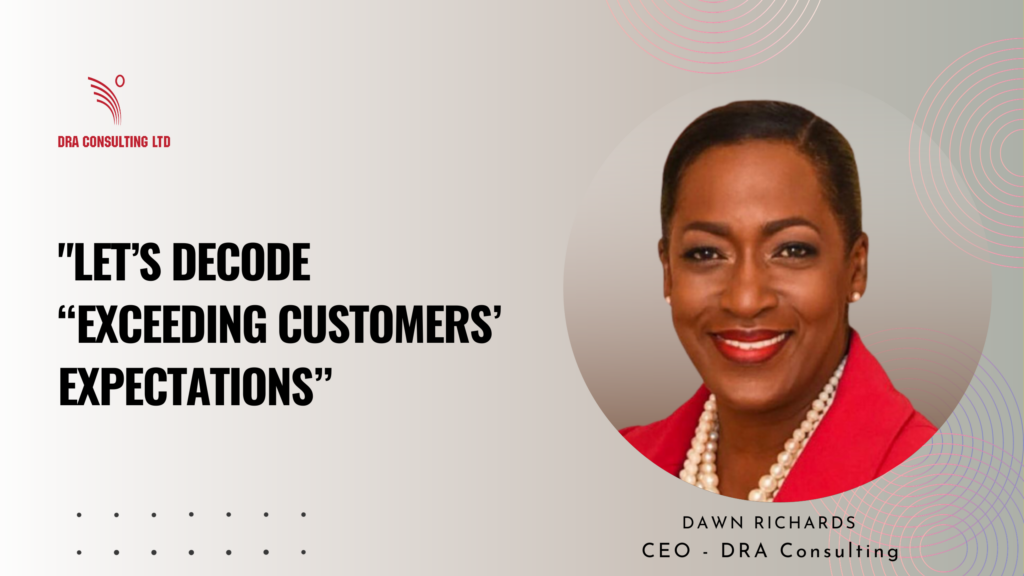So, let’s start this week’s reflection on customer experience with a poll. How many of us have interacted with businesses which have stated boldly, that their service delivery is powered by the aspiration to “exceed their customers’ expectations?” Hmmm….unsurprisingly, quite a few of us!!
I will not conduct a follow-on poll to determine how many of us have experienced the achievement of this aspiration. Those instances when our expectations were exceeded, in deed. I will leave this as a hanging question.
There are several authentication criteria that need to be met by any business that makes the assertion of exceeding customers’ expectations. One criterion to be met, would be for the business to possess significant customer intelligence through thorough, rigorous and ongoing research that identifies customers’ wants, needs and preferences. Thus, enabling the business to know and understand its customers, inside out. Can’t exceed if you don’t know what parameters need to be exceeded.
There are several authentication criteria that need to be met by any business that makes the assertion of exceeding customers’ expectations.
Another criterion would be for the business to have attained a significant level of efficiency, in order to escalate its operations to the superlative height of exceeding expected standards of excellence. Achieving this level of excellence is a tall order for any business. What I’ve discovered, is that some businesses have not defined fully, what success at being efficient really means. What is commonplace in business environments, is a generalized understanding of the parameters or standards of efficiency, especially those that are pegged to measurable indicators as sales targets or call resolution rates.
I am unsure about how many businesses create a distributed communication strategy to ensure that all employees are provided with a handbook that expresses how the business measures efficiency. For example, would it not be efficient to generate proof-of-efficient statements that read like this for example, “We are efficient when we deliver a transaction with zero errors, 100% of the time?” In this way, it becomes easy to exceed customers’ expectations because minimum efficiency standards would have been articulated.
One criterion to be met, would be for the business to possess significant customer intelligence through thorough, rigorous and ongoing research that identifies customers’ wants, needs and preferences.
Next, the business will need to boast of a thriving internal ecosystem, where all of the moving parts including the people, the processes, the technology and the culture, intersect with orchestrated efficiency. Picture this. A business with leadership disunity, lack of horizontal co-ordination (also known as silo operations), a toxic culture, disaggregated pockets of efficiency, a hit and miss style of service delivery and disengaged employees, cannot deliver orchestrated efficiency.
On the other hand, a business that boasts distributed leadership that is committed to releasing brilliance, a green culture, the right mix of right-minded, right-skilled talent and operational efficacy, is well poised for its journey to achieving a thriving ecosystem. Another win for exceeding expectations.
Thus, enabling the business to know and understand its customers, inside out. Can’t exceed if you don’t know what parameters need to be exceeded.
To me, any business that vaunts a claim of exceeding customer expectations in the public domain, will need to meet the foregoing criteria, to qualify for the approval that goes with the declaration.
The obvious question is, of course, “Is such a claim achievable?” The immediate answer is, yes. There are those businesses that are meeting the authentication criteria and exceeding their customers’ expectations. But getting into this exclusive community takes a bit of effort.
A business will need to begin with the end in mind, by acknowledging that exceeding customers’ expectations is a lagging metric. It is measured after the fact. What is more crucial, is the effort, planning and execution that goes ahead.
Another criterion would be for the business to have attained a significant level of efficiency, in order to escalate its operations to the superlative height of exceeding expected standards of excellence.
When the focus is on getting leading metrics right, I believe that setting objectives, targets and performance indicators are taken more seriously. This, in turn, creates a deeper commitment to eliminating challenges or constraints that stand in the way of doing things well. A new level of elegance and finesse will begin to characterize the footprint of the business as a brand that elevates the most miniscule activity, to a command performance that is memorable.
Overcoming perception blindness is another imperative. The sin of perception blindness occurs when a business yields to conjecture, presumptions and guesswork when profiling its customers, instead of being reliant on validated sources for gaining insight, such as a voice of the customer channel.
Investing in effective mapping of the customer’s journey allows a business to identify and “anticipate” important touchpoints, pain points and empathy points that matter to the customer. These impression points can now enable a business to craft moments of truth that, in turn, trigger the pathways to exceeding customers’ expectations.
A lacuna exists between the intent and the achievement of exceeding customers’ expectations. I’ve discovered that smart businesses do everything in their power to bridge this gap.

